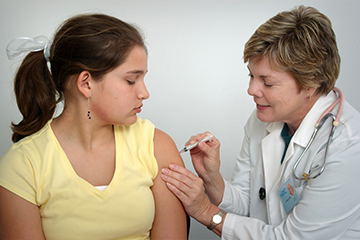Cervical Cancer

What is cervical cancer?
A woman’s cervix is the lower, narrow end of the uterus (the hollow, pear-shaped organ where a foetus can grow). The cervix leads from the uterus to the vagina (birth canal) below.
Cervical cancer is a disease in which the cells of the cervix becomes abnormal and start to form tumours. The symptoms vary from woman to woman. Some women will experience no symptoms, while others may have severe symptoms.
What causes cervical cancer?
In most cases, the Human Papillomavirus (HPV) is the virus that causes cervical cancer. You can get HPV by having sexual contact with someone who has it. There are many types of HPV, but not all types of HPV cause cervical cancer. Some of them cause genital warts, but other types may not cause any symptoms.
Signs and symptoms
The Cancer Association of South Africa lists the following to look out for:
- Abnormal vaginal bleeding between periods.
- Continuous vaginal discharge.
- Menstual periods becoming heavier and lasting longer.
- Vaginal bleeding or pain during sexual intercourse.
- Increased urinary frequency.
- Vaginal bleeding after menopause.
Prevention
To prevent cervical cancer, women should consciously make healthy lifestyle choices and create an environment that may help others in choosing a healthy lifestyle. Some preventative measures would be to stop or preferably never start smoking and to prevent or manage sexually transmitted diseases.
How is cervical cancer detected?
The earlier abnormalities in the cervix cells are detected, the better the chances will be of treating the cancer successfully.
A Pap smear is done to check for changes in the cells of a woman’s cervix. The test can identify any abnormalities or infections that may be found in the cells. The advantages of going for regular pap smear check-ups is that the earlier the disease is detected, the quicker the treatment may be implemented. All women 30 years and older should be tested for cervical cancer during her lifetime.
Pap smears

What is a Pap smear?
A Pap smear is a quick examination to check the cervix (mouth of the womb). A trained nurse or doctor takes a small brush or spatula to remove cells from the cervix and sends it off for testing to determine whether cancer cells are present.
What do the medical staff look out for when they do a Pap smear?
Medical staff do a full external and internal examination to look for any visible signs of sexually transmitted infections or any other pathology that will need attention.
What should women do or not do to avoid negative results of a pap smear?
- Young women should delay having sex.
- Have pap smears every 10 years starting from the age of 30 to ensure early detection.
- Seek medical help if there are signs and symptoms of infection e.g. substantial and/or pungent vaginal discharges, lower abdominal pain, abnormal bleeding, etc.
- Always use condoms.
- General healthy lifestyle.
What are the benefits of going for a pap smear and when must they go for one?
With the early detection of cancer cells or infections, treatment can start earlier. In government facilities, all women 30 years and older can have 3 free Pap smears at 10-year intervals.
What services are available to the public? (So where can they go and how do they access it?)
Pap smear services are available at all health care facilities Monday to Friday. Some facilities offer extended hour sessions to accommodate working women.
A clinical breast examination is also done with every pap smear to detect signs and symptoms of breast cancer.
Why is the Human Papillomavirus vaccination necessary?
Human Papillomavirus (HPV) is the virus that causes cervical cancer. The vaccination protects girls from being infected by HPV and thus reduces the risk of developing HPV related cervical cancer later in life. Cervical cancer is the second most prevalent cancer among women after breast cancer. Close to 80% of cervical cancers are caused by HPV.
Statistics on HPV
- The incidence rate of cervical cancer in South Africa is reported between 22.8 and 27 per 100 000 women as compared to the global average of 15.8.
- Annually there are some 5 743 new cases reported with 3 027 associated deaths in South Africa.
- 99% of cervical cancers are associated with HPV.
- About 7 in every 10 people will have HPV at some point in their lifetime.
- Two strains of HPV (HPV-16 and HPV-18) are found to cause over 70% of the cervical cancer cases.
- Cervarix®, that was provided, protects against HPV-16 and HPV-18 strains.
- The World Health Organization has recommended vaccinating girls before they are sexually active (between 9 and 13 years).
Read the frequently asked questions about the Human Papillomavirus (HPV) Vaccination:
- National Cervical Cancer Prevention and Control Policy (Guidelines, Manuals and Instructions)
- Cervical Cancer Screening (Service)
- HPV vaccinations (Public Information)


